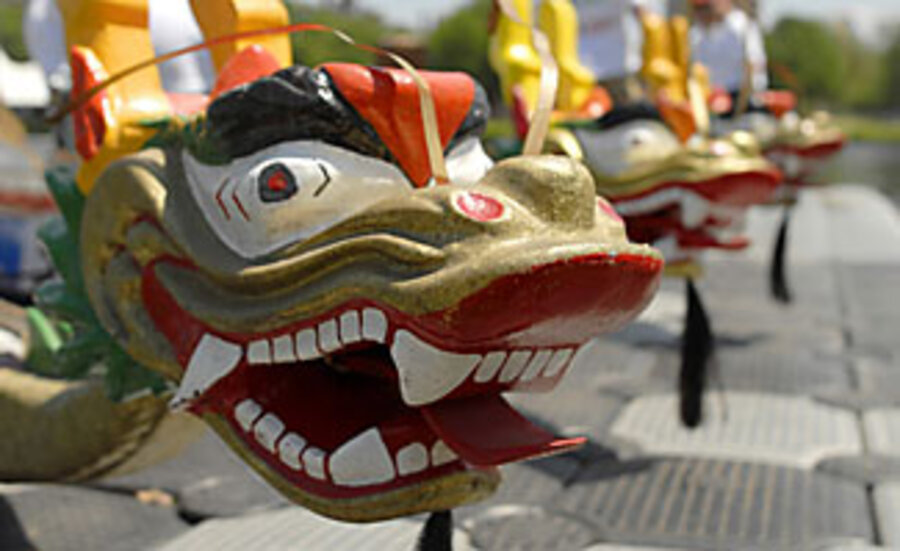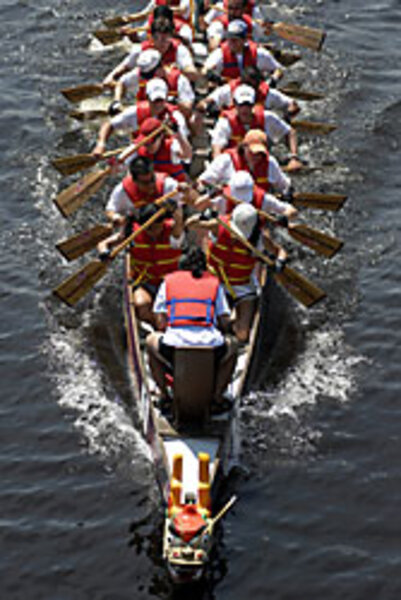Modern crews sign on for ancient Chinese dragon boat racing
| Cambridge, Mass.
The first thing you might notice about the motley crew of men and women stretching out along the bank of the Charles River on a recent sultry Sunday afternoon is how different they look from one another. If they weren't lined up two-by-two in matching black-and-white racing shirts with the same logo, you might mistake them as contenders for America's Got Diversity, rather than a dragon-boat team busy making waves on the east coast racing circuit.
Yes, you read that right. Dragon-boat team.
These members of the Living Roots team – including a scrappy nuclear engineer, a studly but quiet Jamaican soccer player, a 15-year-old high school student, a pregnant health services executive, a scrawny grad student from India, and an unassuming young elementary schoolteacher – are going to pile into a couple of 40-foot long, 1,500-pound gondolalike canoes made of teak and fiberglass. The boats are tricked out with a dragon head and Chinese drum – about the size of a medium barrel – at the bow. At the stern is a platform for the steerer to command the rudder, while deftly avoiding harm to the dragon tail. (Yes, nautical purists, steerer is correct.)
At the sound of a horn they're going to dig and churn their way upstream – 20 people to a boat – aiming for 11 m.p.h. in the nautical equivalent of, say, drag racing souped-up classic cars.
Dragon-boat racing, which originated in ancient China, is a fast-growing sport – known for its democratic inclusion, both social and physical. If you can hold a paddle, you can be on a team. There's no jock hierarchy to exclude the skinny, the old, or the untrained.
An estimated 100,000 people in North America participate in races like today's Boston Dragon Boat Festival each year, according to the International Dragon Boat Federation.
This year about 3,000 teams are expected to compete in races in more than 100 US cities – that's a 20 percent increase over just two years ago. This year's Boston festival, for example, has 31 boats entered, up from 21 a year ago.
It's the walk-on appeal that's driving the growth of the sport, suggests Jay Coakley a sociologist who has written textbooks on sport and society. "The diversity of the teams is related to the fact that ... no credentials are needed, such as playing on a high school team ... taking lessons from so and so. It's democratic and inclusive by default – a refreshing thing for many of us."
He adds that part of the recent interest in the sport in the US has to do with Beijing. "The Olympics is shining a light on China and the complex and mixed scenes and stories we see and hear have attracted a great deal of attention and interest."
Photos of the Olympic torch being paddled across a river in China via dragon boat this spring especially charged paddlers says Sunny Lamm, coordinator of Montreal's annual International Dragon Boat Race Festival (July 26-27). "It's definitely, one of the fastest growing water sports in the world," says Mr. Lamm, who has been paddling and organizing races for a decade and is convinced the reason dragon-boat festivals have been popping up in more cities is that "it's a sport for anyone. We've had kids as young as 12 compete with 95-year-old breast cancer survivors. Really, anyone can learn it."
Dragon boating invites diversity.
• • •
Mike Chung, a buff transportation planner stands on the grassy bank of the Charles next to his paddling teammate antithesis, Karla Kasdan, just about the tiniest and the oldest member of Boston's Living Root club team.
"No one even batted an eyelash," says the platinum blond Ms. Kasdan of the day she presented her 4-feet 11-inch self at her first team practice a little over a year ago. Nor was the detail that she was old enough to be the mother of half the team an issue.
Living Root teammates are waiting for the officials to call them to their boats in Boston's 28th annual dragon-boat race – the oldest in the country. This is their first race after a long winter of practicing three times a week lined along the deck of a swimming pool, digging paddles from their perch and developing lopsided triceps on their favored side. And though not everyone on the team has arrived at today's mettle-proving event able to do crunches in time or are capable of perfect push-up form, the cohesiveness – and synchronization – of the team trumps all that.
No joke: It takes little more than a stray glance before paddles knock, elbows bang heads, or the boat veers into a bridge support beam. Living Root's team happens to know this from experience. After a few months of dragon boating, the paddlers seem to develop a super power where they tune into one another and the rhythm of the boat to avoid the handicap of "caterpillaring" – what the boat looks like when the team is not in perfect synch.
"You realize how important it is to really do things for the team. You get to race time, and you think, 'Ah man, I gotta do this! For the team,' " explains Kasdan, an intensive care nurse, who's never been involved in anything close to a team sport before.
Her teammate, Mr. Chung, agrees: "You know, it doesn't matter who you are or where you come from with this sport. It's that everyone tries and works together. That's it."
Wanting something more interesting than a treadmill at the gym after work, he found dragon boating through Craigslist. The promise of a workout, once you grab a paddle, that hits muscles neither sportsman nor nonsportsman knew they had was a huge plus for him.
But it was the friendly competitive spirit of dragon boating that kept bringing him back.
• • •
Three of the long boats are lined up now in the middle of the Charles, waiting for the starting horn. The 20 people aboard each boat are still – their diversity is moot now, they are one.
Kasdan closes her eyes for a moment, hands gripping paddle, body poised, like those of her teammates, leaning forward, waiting. She concentrates on listening for the signal. A couple of seats away, Chung is going over the route mentally, visualizing how his first few deep paddles will look as the team moves out and up to cover the 500 meter course. He reminds himself not to steal a glance at the other boats and to focus on the rhythm of the paddler in front of him.
The crackle of the starter's megaphone breaks the silence: "Drummers, are you ready?"
As the horn blares, each boat drummer pounds out a steady tempo and paddles plunge and pull – like 18 pistons in perfect time.
The instructions that drummers shout to their crews float on the breeze, heard on shore as Zenlike phrases, such as: "There is nothing but this boat." (Indeed, Kasdan explains later, "It takes so much mental energy to just ignore everything that's going on around you, to not take a peek to see where the other boats are.... The races are so fast, all it takes is a fraction of second to win – to change everything.")
Dragon heads bob neck-and-neck in a mad but mostly synchronized dash little changed from the sport's origins 2,300 years ago.
Living Root plows the distance in 2 minutes, 25.27 seconds – fast enough to get this ragtag crew a second place in the heat. "That was maybe the hardest 2 minutes and 25 seconds of my life" says Kasdan of the immense effort put into the race.
She pauses, considering her sport: "There's just no way my life would have crossed paths with all these people on this team if I hadn't joined dragon boating. That's exciting. That's worth it."






